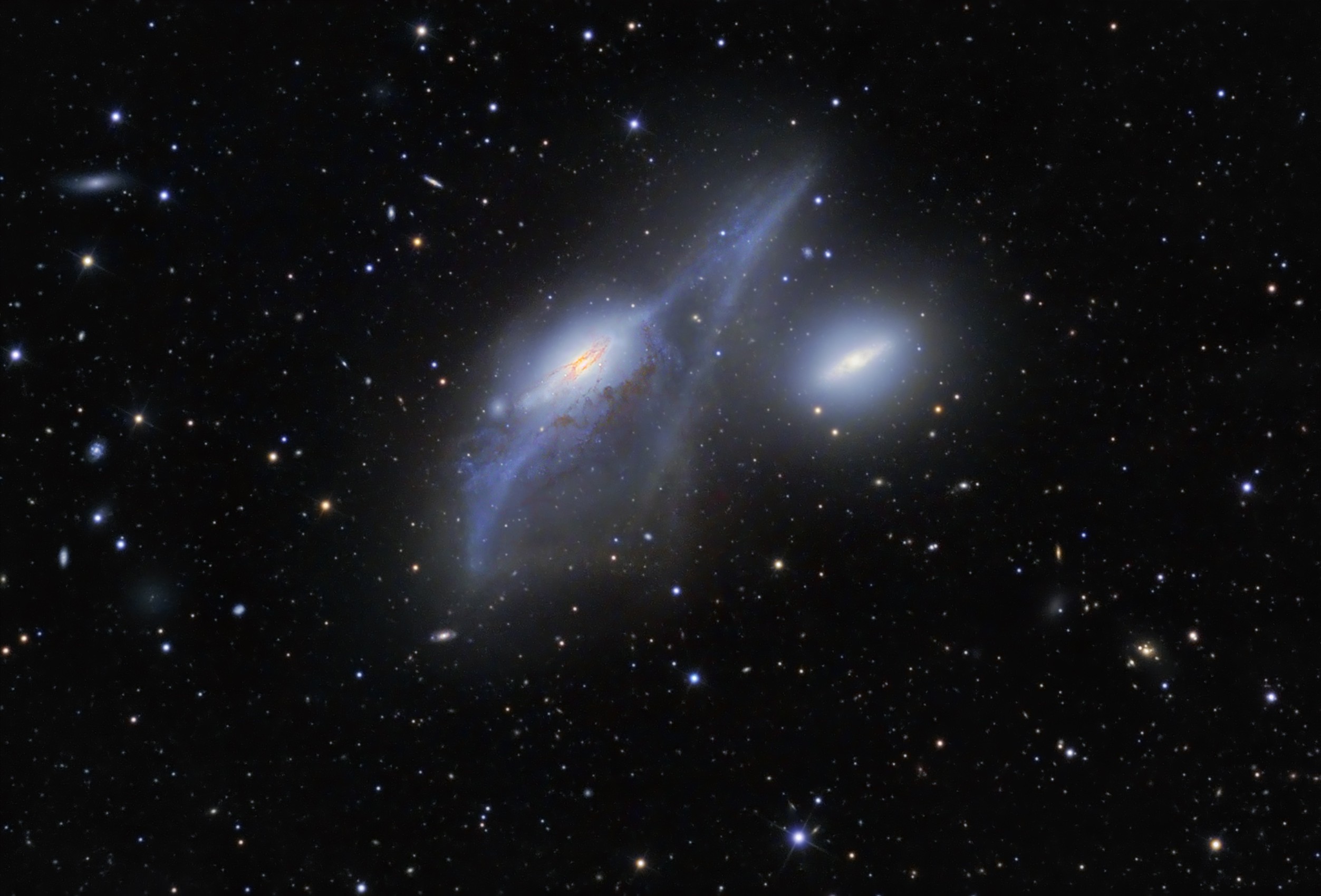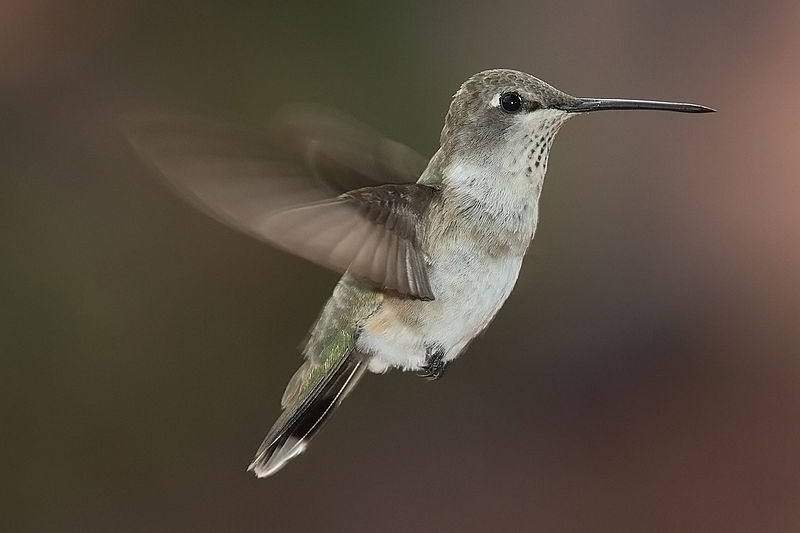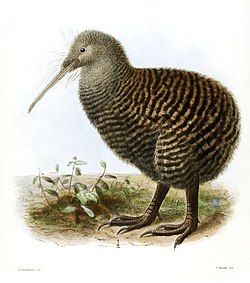Page 1 of 2
APOD: The Porpoise Galaxy from Hubble (2013 Jun 24)
Posted: Mon Jun 24, 2013 4:05 am
by APOD Robot
 The Porpoise Galaxy from Hubble
Explanation:
The Porpoise Galaxy from Hubble
Explanation: What's happening to this spiral galaxy? Just a few hundred million years ago, NGC 2936, the upper of the two large
galaxies shown, was likely a
normal spiral galaxy -- spinning, creating stars -- and minding its own business. But then it got too close to the
massive elliptical galaxy NGC 2937 below and took a dive. Dubbed the
Porpoise Galaxy for its iconic shape, NGC 2936 is not only being deflected but also being distorted by the
close gravitational interaction. A burst of young blue stars forms the nose of the porpoise toward the left of the upper galaxy, while the center of the spiral appears as an eye. Alternatively, the galaxy pair, together known as
Arp 142, look to some like a
penguin protecting an egg. Either way, intricate dark dust lanes and bright blue star streams trail the troubled galaxy to the lower right. The
above recently-released image showing
Arp 142 in unprecedented detail was taken by the
Hubble Space Telescope last year.
Arp 142 lies about 300 million light years away toward the constellation, coincidently, of the Water Snake (
Hydra). In a billion years or so the two galaxies will likely merge into one larger galaxy.
[/b]
Re: APOD: The Porpoise Galaxy from Hubble (2013 Jun 24)
Posted: Mon Jun 24, 2013 4:46 am
by bystander
Re: APOD: The Porpoise Galaxy from Hubble (2013 Jun 24)
Posted: Mon Jun 24, 2013 6:35 am
by Ann
The ex-spiral galaxy, NGC 2936, looks fascinating indeed. It is hard not to admire its perfect avian beak, eye, head and neck.
It is fascinating, too, that the spiral galaxy is so distorted while the elliptical galaxy looks perfectly undisturbed. This says something fundamental about the distribution of mass in spiral and elliptical galaxies. Spirals are "fluffy" and
spread their mass around, whereas ellipticals tend to "pull themselves together", forming tight balls. Obviously the tight balls are harder to disturb than the fluffy, extravagant spiral arms.
Fascinatingly, according to my software, the disturbed ex-spiral NGC 2936 is brighter than the elliptical galaxy, NGC 2937. Obviously the distorted spiral is larger than the elliptical, and it also contains many young bright blue stars, whereas NGC 2937 is entirely made up of old red stars.
It is likely that the elliptical galaxy is more massive than the bird-shaped spiral. The fact that the spiral is nevertheless brighter than the elliptical says something about the nature of the stars that make up these two galaxies.
Ann
Re: APOD: The Porpoise Galaxy from Hubble (2013 Jun 24)
Posted: Mon Jun 24, 2013 6:46 am
by mikeabram
Could it be that a large difference in angular momentum of the two galaxies contributes to the absence of distortion in the eliptical?
Re: APOD: The Porpoise Galaxy from Hubble (2013 Jun 24)
Posted: Mon Jun 24, 2013 7:18 am
by Sinan İpek
With its elongated beak, this galaxy looks rather like a river dolphin to me.
Re: APOD: The Porpoise Galaxy from Hubble (2013 Jun 24)
Posted: Mon Jun 24, 2013 9:34 am
by starsurfer
The world has become a happier place today!!

I'm so happy I could hug Ann!

Re: APOD: The Porpoise Galaxy from Hubble (2013 Jun 24)
Posted: Mon Jun 24, 2013 11:57 am
by r9brown
It occurs to me that I can't explain how galaxies can collide if all matter originated at, and is moving away from, a Big Bang singularity. Why aren't galaxies continually getting further apart?
Re: APOD: The Porpoise Galaxy from Hubble (2013 Jun 24)
Posted: Mon Jun 24, 2013 12:10 pm
by Ann
starsurfer wrote:The world has become a happier place today!!

I'm so happy I could hug Ann!

Hugs right back at you, starsurfer!

It's great to see a galaxy here, isn't it?

As for why the elliptical galaxy in this interacting pair is so undisturbed, the best explanation is probably that at least some elliptical galaxies are quite compact. Others, however, do have large halos and shells which are remnants of previous mergers. Check out, for example,
this image of lenticular galaxy NGC 1316. Merging with a smaller (probably spiral) galaxy has adorned this galaxy with dust lanes in its large bulge and a pair of large broad ghostly "arms".
Check out, too,
this picture of the Hercules cluster of galaxies by Adam Block. Note the pair of interacting galaxies at one o'clock. The galaxies have thrown out arm-like ghostly broad tidal tails.
And of course, the elliptical component of
everyone's favorite interacting pair, M51 and NGC 5195, also shows very clear signs of interruption. But even here, the tidal feature of NGC 5195 are so much fainter than the splendid arms of M51.
Large elliptical galaxies typically show a set of nesting "shells" as remnants of previous mergers.
Here you can see the shells of NGC 5128.
Ann
Re: APOD: The Porpoise Galaxy from Hubble (2013 Jun 24)
Posted: Mon Jun 24, 2013 12:22 pm
by geckzilla
r9brown wrote:It occurs to me that I can't explain how galaxies can collide if all matter originated at, and is moving away from, a Big Bang singularity. Why aren't galaxies continually getting further apart?
Why aren't we getting farther away from the sun? Why doesn't the moon fly away? Galaxies which are close enough gravitationally interact.
Re: APOD: The Porpoise Galaxy from Hubble (2013 Jun 24)
Posted: Mon Jun 24, 2013 12:33 pm
by rui993
Hi all.
Wandering why dust lanes don't have same distortion as the stars ?
Re: APOD: The Porpoise Galaxy from Hubble (2013 Jun 24)
Posted: Mon Jun 24, 2013 12:36 pm
by neufer
I really don't see the porpoise of this APOD.
Re: APOD: The Porpoise Galaxy from Hubble (2013 Jun 24)
Posted: Mon Jun 24, 2013 12:40 pm
by MadMan
I thought it looked like a dolphin at first, but quickly changed my mind. It's a humming bird. You can't see its wings because they're moving too fast

Re: APOD: The Porpoise Galaxy from Hubble (2013 Jun 24)
Posted: Mon Jun 24, 2013 12:44 pm
by leon.l7027@gmail.com
I vote for Penguin and Egg.
Re: APOD: The Porpoise Galaxy from Hubble (2013 Jun 24)
Posted: Mon Jun 24, 2013 1:04 pm
by Rathkennamike
Is that some sort of 'Lensing' effect in the top left hand corner (view full size) causing a little circle of distant galaxies
Re: APOD: The Porpoise Galaxy from Hubble (2013 Jun 24)
Posted: Mon Jun 24, 2013 1:30 pm
by stephen63
Ann wrote:
As for why the elliptical galaxy in this interacting pair is so undisturbed, the best explanation is probably that at least some elliptical galaxies are quite compact. Others, however, do have large halos and shells which are remnants of previous mergers. Check out, for example,
this image of lenticular galaxy NGC 1316. Merging with a smaller (probably spiral) galaxy has adorned this galaxy with dust lanes in its large bulge and a pair of large broad ghostly "arms".
Check out, too,
this picture of the Hercules cluster of galaxies by Adam Block. Note the pair of interacting galaxies at one o'clock. The galaxies have thrown out arm-like ghostly broad tidal tails.
And of course, the elliptical component of
everyone's favorite interacting pair, M51 and NGC 5195, also shows very clear signs of interruption. But even here, the tidal feature of NGC 5195 are so much fainter than the splendid arms of M51.
Ann
Ann,
I'm truly disappointed that you didn't post this as an example of an interacting galaxy pair. As much as Bystander posts here, I mean, c'mon


Re: APOD: The Porpoise Galaxy from Hubble (2013 Jun 24)
Posted: Mon Jun 24, 2013 2:03 pm
by Ann
Ooops! My mistake!
I guess I tend to forget about these guys because, contrary to appearances here, they really aren't blue
at all. Therefore they just don't make me pay attention and say, oh, I've got to remember these two. NGC 4438, the "arm-y" one, has a B-V index of +0.850. And a U-B index of +0.500! NGC 4435, the armless one, is even redder: its B-V index is +0.940 and its U-B index is + 0.655! That's red, there's nothing for it. The B-V index of the Sun is approximately +0.650 and its U-B index is about +0.195. So the Sun is
much bluer than these two guys! If you think the Sun is yellow, then NGC 4435 and 4438 must be positively orange!
But whether they are carrot-tops or not, they make a pretty pair, certainly!

Ann
Re: APOD: The Porpoise Galaxy from Hubble (2013 Jun 24)
Posted: Mon Jun 24, 2013 2:06 pm
by BMAONE23
To me, it would seem more aptly named the Hummingbird Galaxy
Courtesy WIKI
Re: APOD: The Porpoise Galaxy from Hubble (2013 Jun 24)
Posted: Mon Jun 24, 2013 2:10 pm
by neufer
BMAONE23 wrote:To me, it would seem more aptly named the Hummingbird Galaxy
Re: APOD: The Porpoise Galaxy from Hubble (2013 Jun 24)
Posted: Mon Jun 24, 2013 2:45 pm
by bystander
Re: APOD: The Porpoise Galaxy from Hubble (2013 Jun 24)
Posted: Mon Jun 24, 2013 3:41 pm
by Beyond
Hmm... the title of this thread might have to be changed to 'Critter POD'.


Re: APOD: The Porpoise Galaxy from Hubble (2013 Jun 24)
Posted: Mon Jun 24, 2013 3:46 pm
by Boomer12k
Beautiful picture.
I vote Penguin and Egg...Emperor Penguin, as the dust-lane looks like "Eyebrows". It even has "Feet"...
In the Larger image when you click on it, you see another galaxy at the top....what is it, and does it interact with the other two????
:---[===] *
Re: APOD: The Porpoise Galaxy from Hubble (2013 Jun 24)
Posted: Mon Jun 24, 2013 4:22 pm
by LocalColor
Stunning APOD!

Due to the angle and rapid wing beat this hummingbird appears to have tiny wings.
http://tinyurl.com/knyrhhn
Rufous
Re: APOD: The Porpoise Galaxy from Hubble (2013 Jun 24)
Posted: Mon Jun 24, 2013 6:46 pm
by ta152h0
Truck, meet volkswagen
Re: APOD: The Porpoise Galaxy from Hubble (2013 Jun 24)
Posted: Mon Jun 24, 2013 6:52 pm
by geckzilla
I was thinking
rockhopper, myself.
Re: APOD: The Porpoise Galaxy from Hubble (2013 Jun 24)
Posted: Mon Jun 24, 2013 9:39 pm
by LS Thomas
Hello,
Today's picture contains a lot of interesting information. But I feel it is lost on me because so many objects are mentioned that all I take away is that it sure is a pretty picture. To assist with clarity, would you please produce one of those handy overlays that either has circles around or arrows to the different objects with their associated names. Then I will have a chance at putting it all together and reaching an understanding.
Thanks so much.
LS Thomas
 The Porpoise Galaxy from Hubble
The Porpoise Galaxy from Hubble




